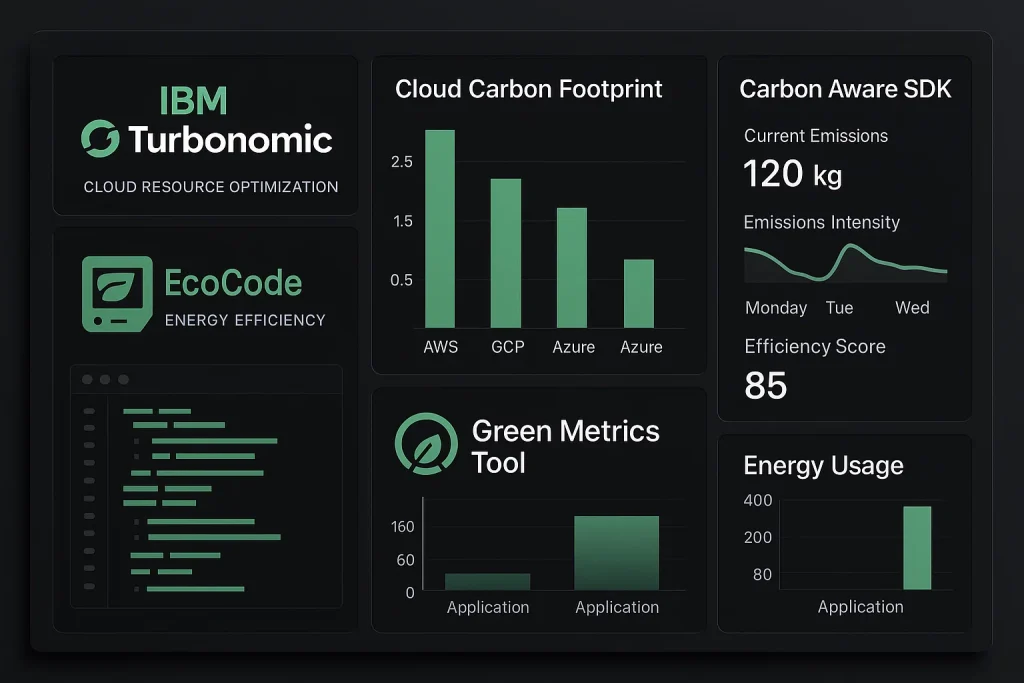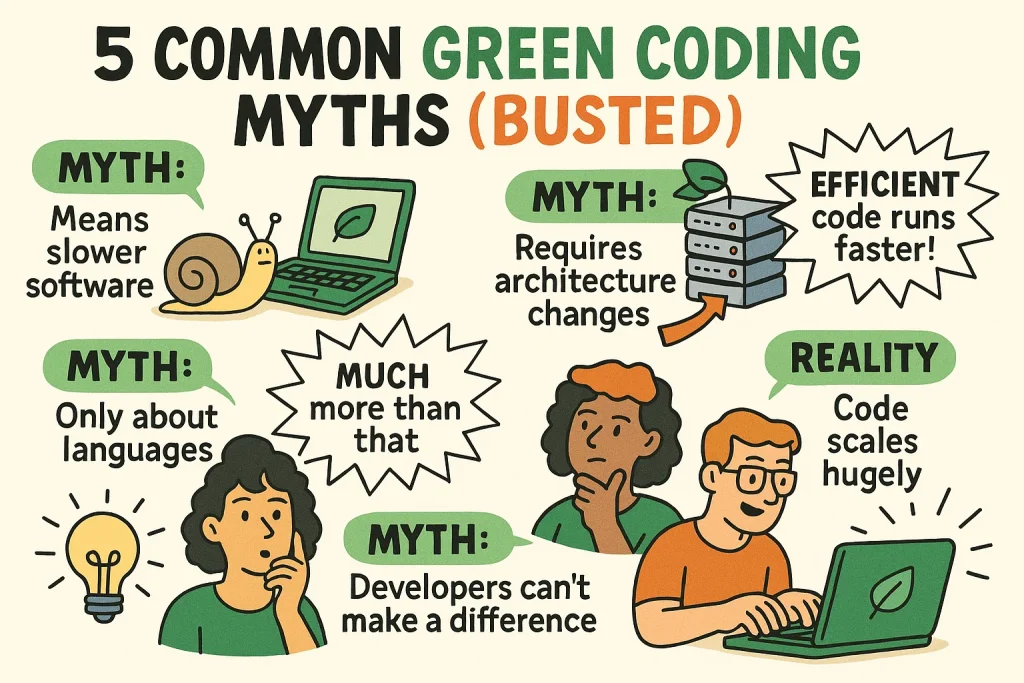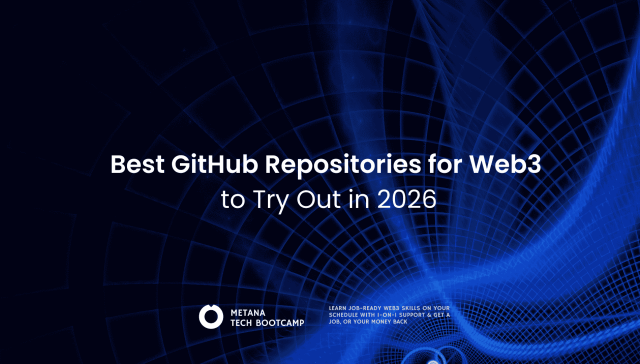TLDR:
Green coding is the practice of writing software that minimizes energy consumption and reduces carbon impact. It’s about building efficient, scalable, and sustainable applications without sacrificing performance.
13 Practical Ways to Apply Green Coding
- Choose Energy-Efficient Languages
Use C or Rust for compute-heavy workloads; keep developer-friendly languages like Python/JS for business logic. - Minimize Dependencies
Audit libraries, drop unused packages, and replace heavy frameworks with lightweight alternatives. - Write Lean Algorithms
Optimize complexity (avoid O(n²) where possible), use proper data structures, and cache expensive operations. - Optimize Database Queries
Add indexes, avoidSELECT *, paginate results, and push aggregations to the database. - Implement Smart Caching
Layer caching across browser, CDN, app, and database levels with proper invalidation strategies. - Reduce Unnecessary API Calls
Batch requests, debounce user interactions, cache responses, and use WebSockets instead of polling. - Compress & Minify Assets
Use next-gen image formats (WebP/AVIF), remove unused CSS/JS, and enable gzip/brotli compression. - Right-Size Your Infrastructure
Use lightweight containers, auto-scaling, and serverless for irregular workloads. - Deploy on Carbon-Aware Clouds
Choose cloud regions powered by renewables (e.g., AWS Oregon, GCP Netherlands). - Use Async Programming Wisely
Run tasks in parallel withPromise.all(), avoid unnecessary blocking, and manage errors correctly. - Refactor Loops & Recursion
Cache loop lengths, break early, avoid deep recursion, and use iterative/memoized solutions. - Monitor with Green Coding Tools
Track usage with tools like Cloud Carbon Footprint, EcoCode, and PowerAPI. - Integrate Sustainability into Code Reviews
Add efficiency checks to PRs, automate linting for energy-hungry patterns, and make it part of team culture.
In this guide, you’ll discover what green coding really means, why it’s becoming a business necessity, and 13 practical techniques you can implement in your very next project to write more sustainable, efficient code.
What Is Green Coding?
Green coding is the practice of developing software that uses minimal computational resources, reduces energy consumption, and minimizes environmental impact throughout the software lifecycle.
Think of it this way: traditional coding focuses on “does it work?” Green coding asks “does it work efficiently?”
Let’s clear up some terminology confusion:
Green Coding specifically refers to writing energy-efficient code—the actual programming practices and techniques you use.
Green Computing is the broader umbrella that includes hardware efficiency, data center management, and sustainable IT infrastructure.
Green Software describes applications built using green coding principles—the end result of sustainable development practices.
How did green computing originate?
The concept emerged from the intersection of two trends:
- Rising energy costs in cloud computing
- Corporate sustainability commitments.
As companies face pressure to meet net-zero targets, they’re discovering that software optimization can deliver both environmental and financial benefits.
Modern development amplifies this need. Cloud-native applications, AI workloads, and microservices architectures can scale resource consumption rapidly. A poorly optimized algorithm might run fine on your laptop but become an energy monster when processing millions of requests in production.
Why Green Coding Matters in 2025
The numbers are staggering. Data centers consumed 200 TWh of electricity in 2020—that’s doubled in the past decade. Cloud computing demand is growing 20-30% annually, and AI workloads are particularly energy-intensive.
Here’s why this affects you directly:
Financial Impact: AWS, Google Cloud, and Azure are increasingly pricing based on actual resource consumption. Efficient code translates to lower cloud bills. Companies report 30-70% cost reductions after implementing green coding practices.
Business Necessity: Over 70% of Fortune 500 companies have committed to net-zero emissions by 2030. Software teams are now being asked to contribute to these goals. Sustainability isn’t just nice-to-have—it’s becoming a competitive advantage.
Career Advancement: Developers who understand sustainable software development are becoming increasingly valuable. It’s a differentiating skill that combines technical excellence with business impact.
Performance Benefits: Here’s the best part—green coding often makes software faster and more reliable. When you optimize for energy efficiency, you typically get better performance as a bonus.
PRO TIP: Start measuring your current applications’ resource usage before implementing changes. You can’t improve what you don’t measure.
13 Proven Ways to Practice Green Coding in Your Next Project
1. Choose Energy-Efficient Programming Languages
Not all programming languages are created equal when it comes to energy consumption. Research from the University of Minho found dramatic differences in energy efficiency across popular languages.
C and Rust top the efficiency charts, using minimal CPU cycles and memory. Go and Java offer good performance for most applications. JavaScript and Python, while developer-friendly, consume significantly more energy.
Practical Application: You don’t need to rewrite everything in C. Instead, identify your application’s bottlenecks. Use efficient languages for compute-heavy operations (like data processing microservices) while keeping productive languages for business logic.
Example: Move your image processing logic from Python to Rust, but keep your web API in Node.js. This hybrid approach balances developer productivity with energy efficiency.
2. Minimize Dependencies and Libraries
Every dependency adds computational overhead. Modern applications often include massive libraries to use just a few functions—like importing an entire UI framework to use one button component.
The Problem: A typical Node.js project can have 1000+ transitive dependencies. Each one adds startup time, memory usage, and potential security vulnerabilities.
Solution Strategy: Audit your dependencies regularly. Replace heavy libraries with lightweight alternatives. Write custom implementations for simple functionality instead of importing entire packages.
Real Example: Instead of importing Moment.js (67KB) for date formatting, use the native Intl.DateTimeFormat API or day.js (2KB). This single change can reduce your bundle size by 97%.
3. Write Lean Algorithms and Data Structures
Algorithm efficiency directly impacts energy consumption. An O(n²) algorithm might work fine with 100 records but becomes an energy vampire with 100,000.
Key Principles:
- Choose the right data structure (HashMap vs Array for lookups)
- Avoid nested loops when possible
- Implement early exit conditions
- Cache expensive calculations
Modern sustainable programming techniques focus on writing algorithms that do more with less computational power.
Code Example: Instead of searching through an array repeatedly, build a lookup map once:
// Energy-hungry approach
const findUserOrders = (userId, orders) => {
return orders.filter(order => order.userId === userId);
}
// Green coding approach
const buildUserOrderMap = (orders) => {
const map = new Map();
orders.forEach(order => {
if (!map.has(order.userId)) map.set(order.userId, []);
map.get(order.userId).push(order);
});
return map;
}
4. Optimize Database Queries for Efficiency
Database operations are often the biggest energy consumers in web applications. Poorly written queries can trigger massive server loads and network traffic.
Essential Techniques:
- Always use indexes on frequently queried columns
- Avoid SELECT * (fetch only needed columns)
- Implement query result pagination
- Use database-level aggregations instead of application logic
Before/After Example:
-- Inefficient: processes entire table
SELECT * FROM orders WHERE customer_id = 123 ORDER BY created_at DESC;
-- Efficient: indexed lookup with specific columns
SELECT id, total, created_at FROM orders
WHERE customer_id = 123
ORDER BY created_at DESC
LIMIT 10 OFFSET 0;
Add an index: CREATE INDEX idx_orders_customer_created ON orders(customer_id, created_at);
5. Implement Smart Caching Strategies
Caching prevents redundant computations and database queries. But intelligent caching goes beyond simple key-value storage.
Multi-Level Approach:
- Browser caching for static assets (CSS, images, fonts)
- CDN caching for globally distributed content
- Application-level caching for computed results
- Database query caching for expensive operations
Smart Implementation: Use time-based expiration combined with dependency invalidation. When user data changes, automatically invalidate related cached results.
Memory Consideration: Set cache size limits to prevent memory bloat. Use LRU (Least Recently Used) eviction policies to maintain optimal memory usage.
6. Reduce Unnecessary API Calls
API calls consume network bandwidth and trigger server processing. Each request has an energy cost on both client and server sides.
Optimization Strategies:
- Batch multiple operations into single requests
- Implement request debouncing for user interactions
- Use GraphQL to fetch exact data requirements
- Cache API responses intelligently
Real-World Example: Instead of making separate API calls for user profile, preferences, and notifications, create a single /dashboard endpoint that returns all necessary data for the initial page load.
WebSocket Alternative: For real-time features, replace frequent polling with WebSocket connections to reduce network overhead.
7. Compress and Minify Your Assets
Large files mean more energy for transmission and processing. Asset optimization is one of the easiest wins in green coding.
Image Optimization:
- Use next-gen formats (WebP, AVIF) with fallbacks
- Implement responsive images with different sizes
- Compress images without quality loss
Code Optimization:
- Minify JavaScript, CSS, and HTML
- Remove unused CSS with tools like PurgeCSS
- Enable gzip/brotli compression on servers
Bundle Analysis: Regularly analyze your bundle size. Tools like webpack-bundle-analyzer show exactly what’s consuming space in your application.
8. Right-Size Your Infrastructure
Running oversized servers wastes energy and money. Cloud auto-scaling helps, but proper sizing prevents waste from the start.
Container Strategy: Use lightweight base images (Alpine Linux vs Ubuntu). A typical Node.js container can shrink from 900MB to 150MB with proper optimization.
Serverless Consideration: For sporadic workloads, serverless functions eliminate idle resource consumption. But be aware of cold start overhead for frequently accessed applications.
Monitoring Approach: Track actual CPU and memory usage over time. Many applications run efficiently on smaller instance types than developers initially assume. Cloud engineers and DevOps professionals are particularly well-positioned to implement energy-efficient software development practices across entire technology stacks.
9. Deploy on Carbon-Aware Cloud Platforms
Not all cloud regions are equal in terms of carbon footprint. Some data centers run entirely on renewable energy, while others rely heavily on coal power.
Regional Selection:
- AWS: us-west-2 (Oregon) runs on renewable energy
- Google Cloud: europe-west4 (Netherlands) is carbon neutral
- Azure: Northern Europe regions prioritize renewable sources
Carbon-Aware Scheduling: Advanced techniques include moving computational workloads to regions with currently clean energy availability. Microsoft’s Carbon Aware SDK helps implement this automatically.
10. Use Asynchronous Programming Wisely
Asynchronous programming can improve energy efficiency by avoiding thread blocking, but incorrect usage can create waste.
Efficient Patterns:
- Use Promise.all() for independent parallel operations
- Implement proper error handling to prevent resource leaks
- Avoid unnecessary async/await for synchronous operations
Common Mistake: Awaiting operations that could run in parallel:
// Inefficient: sequential execution
const userData = await fetchUser(id);
const userOrders = await fetchOrders(id);
// Efficient: parallel execution
const [userData, userOrders] = await Promise.all([
fetchUser(id),
fetchOrders(id)
]);
11. Refactor Loops and Recursive Functions
Loops and recursion can consume significant CPU cycles. Small optimizations compound into major energy savings.
Loop Optimization:
- Cache array length in for-loops
- Use appropriate loop types (for-of vs forEach vs traditional for)
- Break early when conditions are met
- Avoid creating objects inside loops
Recursion Alternatives: Replace deep recursion with iterative solutions when possible. Use memoization for recursive functions with overlapping subproblems.
12. Monitor with Green Coding Tools
Measurement drives improvement. Several tools help track your application’s energy footprint and resource usage.
Essential Tools:
- Cloud Carbon Footprint: Estimates emissions from cloud usage
- EcoCode: SonarQube plugin that flags energy-inefficient code patterns
- PowerAPI: Real-time energy consumption monitoring
- Green Metrics Tool: Measures software energy consumption
Implementation: Integrate energy monitoring into your CI/CD pipeline. Set alerts when resource consumption exceeds baselines.
13. Build Sustainability into Code Reviews
Make green coding part of your team culture through systematic code review practices.
Review Checklist:
- Are there unnecessary dependencies?
- Can algorithms be optimized for better complexity?
- Are database queries indexed and efficient?
- Is caching implemented where appropriate?
Team Education: Share energy impact metrics during retrospectives. Celebrate optimizations that reduce resource consumption alongside feature delivery.
Automated Checks: Use linting rules that flag potentially inefficient code patterns. Many teams add energy efficiency as a definition-of-done criteria. Green coding techniques should become part of every developer’s daily practice.
Essential Tools for Sustainable Software Development

The right tools make green coding accessible and measurable:
IBM Turbonomic provides AI-driven resource optimization for cloud infrastructure, automatically right-sizing applications to reduce waste.
Cloud Carbon Footprint offers detailed emissions tracking across AWS, Google Cloud, and Azure, helping teams understand their environmental impact.
Carbon Aware SDK from Microsoft enables applications to automatically shift workloads based on renewable energy availability.
EcoCode integrates directly into popular IDEs, providing real-time feedback on code energy efficiency during development.
Green Metrics Tool measures actual energy consumption of applications, providing concrete data to guide optimization efforts.
5 Common Green Coding Myths (Busted)

- Myth: Green coding means slower software.
Reality: Efficient code typically runs faster. When you optimize for energy, you usually optimize for performance simultaneously. - Myth: Sustainability requires major architecture changes.
Reality: Many green coding practices are small optimizations that compound into significant impact. You can start with simple changes like image compression and dependency cleanup. - Myth: Green coding is only about choosing programming languages.
Reality: While language choice matters, your algorithms, infrastructure decisions, and development practices have much bigger impacts. - Myth: Individual developers can’t make a meaningful difference.
Reality: Code optimizations scale massively. When millions of users run your application, small efficiency improvements create enormous aggregate impact. - Myth: Green coding limits innovation and creativity.
Reality: Sustainability often sparks innovation. Optimizing for efficiency pushes developers to design smarter algorithms, lighter apps, and more scalable solutions.
Start Coding Sustainably Today
Green coding isn’t just about saving the planet—it’s about writing better software that costs less to run and performs better for users.
Industry standards for measuring software carbon footprints are under development. The Green Software Foundation is creating certification programs for sustainable software engineering practices.
The techniques in this guide aren’t theoretical concepts. They’re practical skills that deliver immediate benefits: lower cloud bills, faster applications, and more sustainable software architecture.
Every optimization you make scales across all your users. When you reduce an API response by 10KB, that saving multiplies by every request your application serves. Small changes compound into massive impact.
Ready to level up your development skills with sustainable programming practices? Metana bootcamps prepare you to code smarter, faster, and greener—skills that matter for the future of tech. Start building software that makes a difference.
Frequently Asked Questions

What is the green code?
Green code (or green coding) is software written to minimize energy consumption and environmental impact. It focuses on writing lean, efficient, and resource-conscious code that reduces CPU cycles, memory usage, and carbon emissions — without sacrificing functionality.
How to write an energy-efficient code?
- Use efficient algorithms (reduce time complexity).
- Minimize nested loops and recursion.
- Optimize database queries (avoid SELECT *).
- Compress and cache resources.
- Profile and remove unnecessary dependencies.
- Choose energy-efficient languages (C, Rust, Go often outperform interpreted ones like Python/JavaScript in power usage).
What are the key principles of green computing?
- Efficiency first – design code and systems to use fewer resources.
- Sustainability mindset – consider energy cost as part of development.
- Optimization at scale – reduce data movement, API calls, and unnecessary computation.
- Lifecycle thinking – from development → deployment → maintenance → disposal.
- Carbon awareness – measure and adjust based on carbon intensity of energy sources.
How to build a green mindset?
- Treat energy cost like performance cost: measure, optimize, repeat.
- Adopt “less is more” coding habits — fewer dependencies, lighter builds.
- Make sustainability part of team culture & reviews.
- Align with company net-zero goals.
- Keep learning about tools that measure energy footprint in coding.
What is a green coder?
A green coder is a developer who consciously applies sustainable software practices — from choosing efficient algorithms to deploying on greener cloud infrastructure. Their goal is to reduce software’s energy footprint, lower costs, and contribute to broader environmental sustainability targets.








